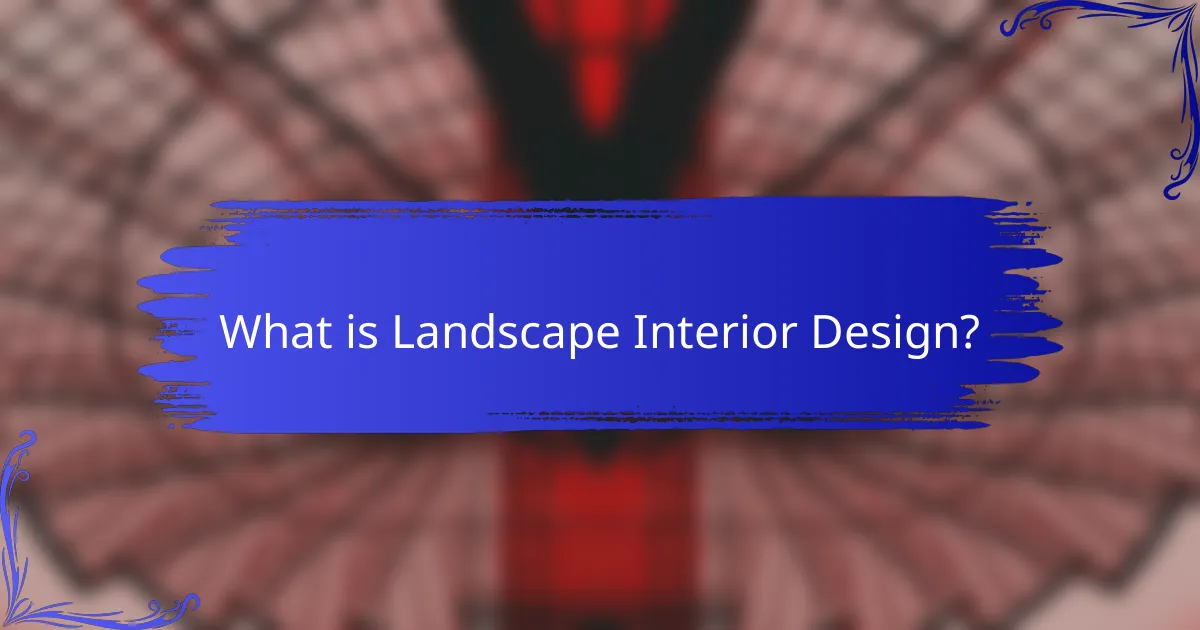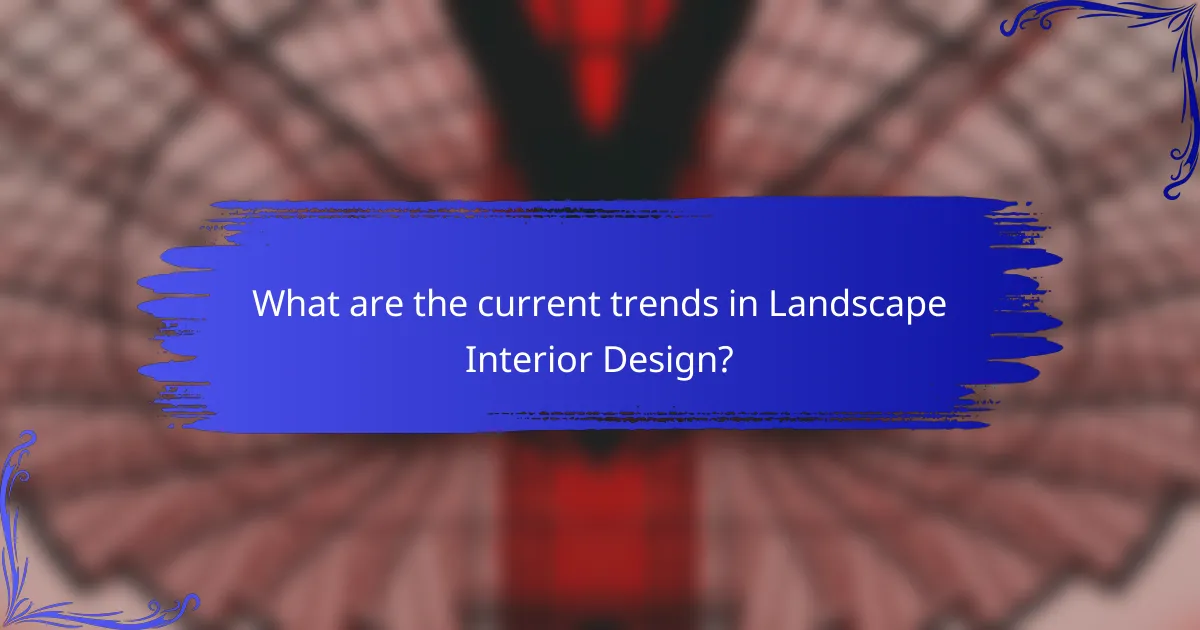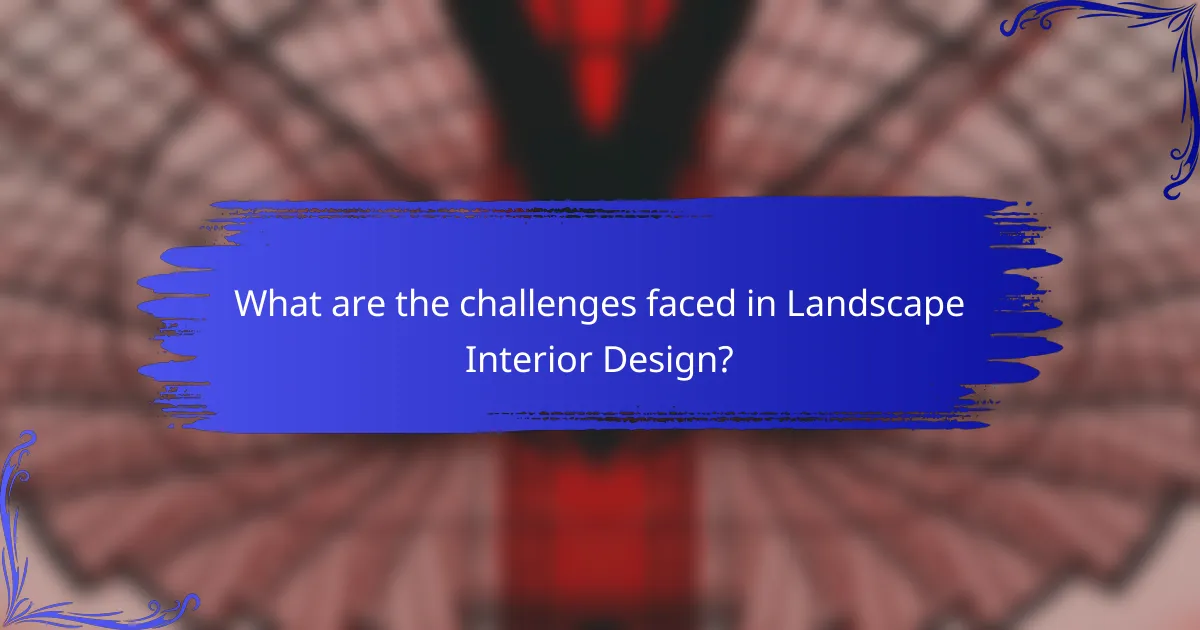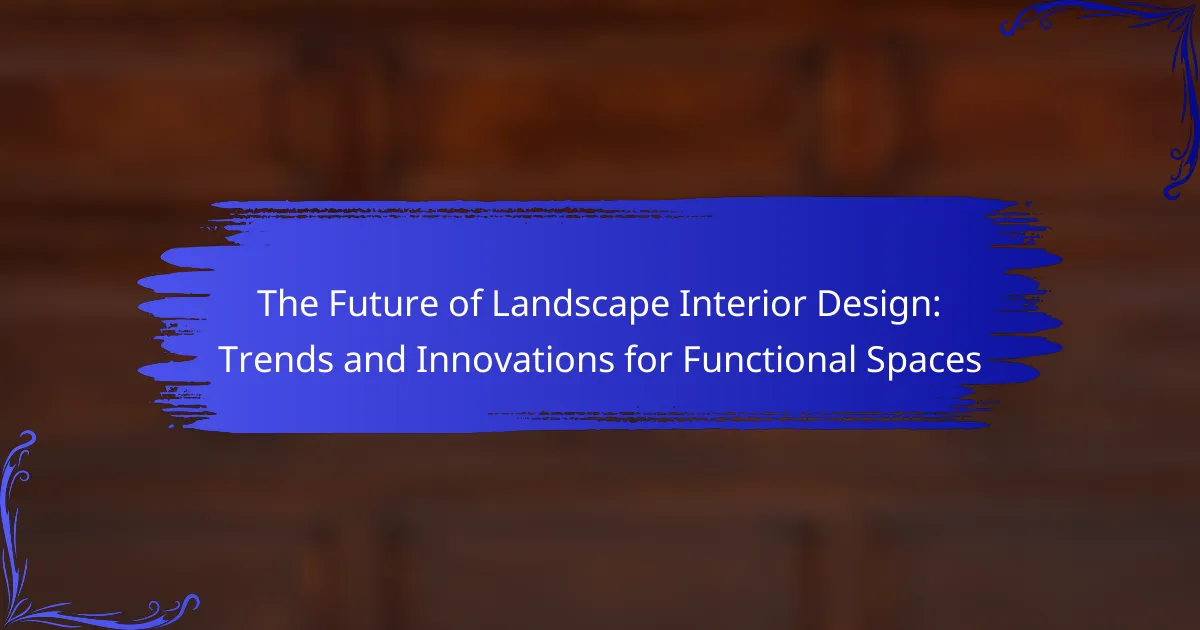Landscape interior design integrates outdoor elements into indoor spaces, creating environments that harmonize nature with architecture. This design approach utilizes plants, natural materials, and light to enhance aesthetics and functionality while promoting well-being and improving air quality. Current trends emphasize sustainability and biophilic design, focusing on using native plants and smart technology to create efficient and eco-friendly spaces. Challenges in landscape interior design include balancing aesthetics with functionality, understanding environmental conditions, and navigating budget constraints and regulatory issues. The article explores these trends and innovations shaping the future of landscape interior design, highlighting its impact on urban living and environmental responsibility.

What is Landscape Interior Design?
Landscape interior design is the practice of integrating outdoor elements into indoor spaces. This design approach focuses on creating harmonious environments that blend nature with architecture. It emphasizes the use of plants, natural materials, and light to enhance aesthetic appeal and functionality. Landscape interior design can improve air quality and promote well-being. Studies show that incorporating greenery indoors can reduce stress and increase productivity. This design trend is becoming increasingly popular in urban settings, where access to nature is limited.
How does Landscape Interior Design differ from traditional interior design?
Landscape interior design focuses on integrating outdoor elements within interior spaces. This approach emphasizes the use of natural materials, plants, and outdoor views. Traditional interior design primarily centers on indoor aesthetics and functionality without significant outdoor integration.
Landscape interior design aims to create a seamless transition between indoor and outdoor environments. It often includes features like living walls, indoor gardens, and large windows to enhance natural light. Traditional interior design typically prioritizes furniture arrangement, color schemes, and decorative elements within the confines of a room.
Research indicates that incorporating nature into indoor spaces can improve mental well-being and productivity. A study by Kaplan and Kaplan (1989) highlights the psychological benefits of nature exposure. This evidence supports the unique focus of landscape interior design on enhancing the human experience through nature.
What are the key principles of Landscape Interior Design?
The key principles of Landscape Interior Design include harmony, balance, scale, and functionality. Harmony ensures that all elements work together cohesively. Balance refers to the visual weight distribution in a space. Scale involves the proportion of objects relative to each other and the overall space. Functionality addresses how the space meets the needs of its users. These principles guide designers in creating aesthetically pleasing and practical environments. Adhering to these principles enhances the overall experience of landscape interiors.
What role does nature play in Landscape Interior Design?
Nature plays a crucial role in Landscape Interior Design by enhancing aesthetics and promoting well-being. Incorporating natural elements creates a harmonious environment. Plants, water features, and natural materials contribute to visual appeal. Studies show that biophilic design improves mental health and reduces stress. Natural light is also vital, as it affects mood and productivity. The presence of greenery can increase property value and attract buyers. Integrating nature fosters sustainability and ecological balance in design. Overall, nature enriches landscape interior spaces, making them functional and inviting.
Why is Landscape Interior Design important for functional spaces?
Landscape interior design is crucial for functional spaces because it enhances usability and aesthetic appeal. This design approach integrates natural elements into indoor environments. By incorporating plants and natural materials, it improves air quality and promotes well-being. Studies show that greenery can increase productivity and reduce stress levels. Functional spaces benefit from thoughtful layouts that facilitate movement and interaction. Effective landscape interior design also considers light and space, optimizing the environment for various activities. Research indicates that well-designed spaces can lead to higher satisfaction and comfort among occupants. Overall, landscape interior design is essential for creating harmonious and functional indoor settings.
How can Landscape Interior Design enhance the functionality of a space?
Landscape Interior Design enhances the functionality of a space by integrating natural elements to improve usability. It creates a seamless connection between indoor and outdoor environments. This design approach optimizes space utilization by incorporating plants, water features, and natural light. Research shows that greenery can increase productivity and reduce stress in workspaces. For instance, studies indicate that workplaces with plants can boost employee productivity by up to 15%. Additionally, well-designed landscapes can facilitate social interactions, making spaces more inviting. Properly planned layouts can also enhance circulation and accessibility. Overall, Landscape Interior Design transforms spaces into multifunctional areas that meet various needs.
What psychological benefits does Landscape Interior Design provide?
Landscape Interior Design enhances psychological well-being by promoting relaxation and reducing stress. Natural elements in design, such as plants and water features, create a calming environment. Studies show that exposure to greenery can lower cortisol levels, which are associated with stress. Additionally, well-designed landscapes improve mood and increase feelings of happiness. A study published in the Journal of Environmental Psychology found that natural views can enhance cognitive function and creativity. Furthermore, engaging with nature through design fosters a sense of connection and belonging. This connection can lead to improved mental health and overall life satisfaction.

What are the current trends in Landscape Interior Design?
Current trends in landscape interior design focus on sustainability and biophilic design. Sustainable practices include using native plants and materials with low environmental impact. Biophilic design emphasizes the connection between indoor spaces and nature. This trend promotes well-being and enhances productivity. Vertical gardens and green walls are increasingly popular. They maximize space while improving air quality. Smart technology integration is also trending. This includes automated irrigation systems and environmental sensors. Outdoor living spaces are being designed as extensions of interiors. This trend encourages social interaction and relaxation. Overall, these trends reflect a growing awareness of environmental responsibility and well-being in design.
How are sustainable practices influencing Landscape Interior Design trends?
Sustainable practices are significantly influencing Landscape Interior Design trends by promoting eco-friendly materials and designs. Designers increasingly incorporate native plants to reduce water usage and maintenance. The use of recycled materials is on the rise, minimizing waste and carbon footprint. Energy-efficient lighting and irrigation systems are becoming standard in new designs. These practices align with consumer demand for sustainability, as 75% of homeowners prefer eco-friendly options. Additionally, biophilic design principles are gaining traction, enhancing well-being through natural elements. Overall, sustainable practices are reshaping the aesthetics and functionality of landscape interiors.
What materials are being favored for sustainable Landscape Interior Design?
Natural materials like reclaimed wood, bamboo, and recycled stone are favored for sustainable landscape interior design. These materials reduce environmental impact and promote eco-friendliness. Reclaimed wood repurposes existing resources, minimizing deforestation. Bamboo grows rapidly and absorbs carbon, making it a sustainable choice. Recycled stone utilizes waste materials, reducing landfill contributions. Additionally, organic textiles and low-VOC paints enhance sustainability. These materials align with the growing trend towards eco-conscious design practices in the industry.
How does biophilic design integrate with current trends?
Biophilic design integrates with current trends by emphasizing a connection to nature in built environments. This approach aligns with the growing demand for sustainable and wellness-focused design. Studies show that incorporating natural elements improves mental well-being and productivity. Current trends in urbanization and environmental awareness support biophilic principles. For example, the use of green walls and natural lighting is increasingly popular in office spaces. Research indicates that plants in indoor environments can reduce stress and enhance creativity. Furthermore, biophilic design is often combined with smart technology to create responsive environments. This integration reflects a holistic approach to modern landscape interior design.
What technological innovations are shaping the future of Landscape Interior Design?
Technological innovations shaping the future of Landscape Interior Design include augmented reality, smart irrigation systems, and drone technology. Augmented reality allows designers to visualize projects in real-time and enhance client presentations. Smart irrigation systems optimize water usage through sensors and automation, promoting sustainability. Drone technology enables precise surveying and mapping of landscapes, improving design accuracy. These innovations lead to more efficient, sustainable, and aesthetically pleasing outdoor spaces.
How are smart technologies being incorporated into Landscape Interior Design?
Smart technologies are being incorporated into landscape interior design through the use of automated irrigation systems, smart lighting, and environmental monitoring devices. Automated irrigation systems optimize water usage by adjusting based on soil moisture levels. Smart lighting enhances outdoor spaces by allowing for customizable lighting schedules and energy efficiency. Environmental monitoring devices track conditions such as temperature and humidity, enabling designers to create more responsive and sustainable landscapes. These technologies contribute to the overall functionality and sustainability of landscape designs, making them more adaptable to changing environmental conditions.
What role do software and design tools play in modern Landscape Interior Design?
Software and design tools are essential in modern Landscape Interior Design. They enhance visualization and planning capabilities. Tools like CAD and 3D modeling software allow designers to create detailed layouts. These technologies facilitate better communication with clients. They enable real-time adjustments based on client feedback. Additionally, software can analyze environmental factors for sustainable designs. Data-driven insights improve decision-making in design processes. The use of these tools streamlines workflows and increases efficiency in project execution.

What are the challenges faced in Landscape Interior Design?
Landscape interior design faces several challenges. One significant challenge is balancing aesthetics with functionality. Designers must create visually appealing spaces that also serve practical purposes. Another challenge involves understanding environmental conditions. Factors like climate, soil type, and local flora can impact design choices. Budget constraints often limit material options and design complexity. Additionally, regulatory issues can complicate project approval and execution. Designers must navigate zoning laws and building codes. Collaboration with other professionals is essential but can lead to communication hurdles. Lastly, sustainability concerns are increasingly important. Designers must incorporate eco-friendly practices while meeting client expectations.
How can designers overcome common obstacles in Landscape Interior Design?
Designers can overcome common obstacles in Landscape Interior Design by employing strategic planning and innovative solutions. Effective communication with clients clarifies expectations and minimizes misunderstandings. Utilizing technology, such as 3D modeling software, enhances visualization and aids in decision-making. Sustainable practices, like selecting native plants, address environmental challenges and reduce maintenance. Regular collaboration with landscape architects ensures a cohesive design approach. Continuous education on emerging trends keeps designers informed and adaptable. By integrating feedback loops, designers can refine their work based on real-world outcomes. These strategies collectively enhance the design process and improve project success rates.
What are the limitations of space in Landscape Interior Design?
Space limitations in Landscape Interior Design include size constraints, zoning regulations, and environmental factors. Limited space restricts the scale and variety of elements that can be incorporated. Zoning regulations can dictate the types of plants and structures allowed. Environmental factors, such as sunlight and drainage, can further limit design options. Additionally, budget constraints may restrict the quality and quantity of materials used. These limitations necessitate careful planning and creative solutions to maximize functionality and aesthetics.
How do budget constraints affect Landscape Interior Design projects?
Budget constraints significantly impact Landscape Interior Design projects. They limit the selection of materials, plants, and design features. Designers must prioritize essential elements over luxury items. This often results in simpler designs that still meet functional needs. Budget restrictions can also influence project timelines, as cost-effective solutions may take longer to source. Furthermore, reduced budgets may necessitate compromises on quality. For instance, using less durable materials can lead to higher long-term maintenance costs. Ultimately, budget constraints shape the overall vision and feasibility of a landscape design project.
What best practices should be followed in Landscape Interior Design?
Best practices in Landscape Interior Design include integrating natural elements, considering site context, and prioritizing sustainability. Integrating natural elements enhances aesthetic appeal and promotes well-being. Site context ensures designs complement the surrounding environment. Prioritizing sustainability involves using eco-friendly materials and practices. Research shows that biophilic design can improve mental health and productivity. Studies indicate that outdoor spaces can reduce stress and enhance creativity. Employing these best practices leads to functional and harmonious spaces.
How can designers effectively balance aesthetics and functionality?
Designers can effectively balance aesthetics and functionality by integrating both elements throughout the design process. Prioritizing user needs ensures that functionality is addressed while maintaining visual appeal. Utilizing materials that are both beautiful and practical contributes to this balance. Employing design principles such as proportion, contrast, and harmony enhances aesthetic value without compromising usability. Iterative prototyping allows designers to test and refine both aspects simultaneously. User feedback is crucial in identifying areas where aesthetics may overshadow functionality. Research indicates that spaces designed with both aesthetics and functionality in mind lead to higher user satisfaction. For example, a study by the American Society of Interior Designers found that well-balanced designs improve overall functionality and user experience.
What tips can help in selecting the right plants for interior landscapes?
Choose plants that thrive in indoor conditions. Consider light availability in the space. Assess humidity levels to select suitable species. Evaluate the size of the area for plant growth. Select low-maintenance plants for ease of care. Match plant aesthetics with interior design themes. Research plant toxicity if pets are present. Utilize native plants for better adaptability.
The main entity of the article is Landscape Interior Design, which focuses on integrating outdoor elements into indoor spaces to create harmonious and functional environments. The article explores key principles, psychological benefits, and current trends in Landscape Interior Design, emphasizing sustainability and biophilic design. It discusses the role of technology and smart innovations in shaping future designs, as well as challenges such as budget constraints and space limitations. Best practices for balancing aesthetics and functionality, along with tips for selecting appropriate plants, are also highlighted to enhance the overall design process.
